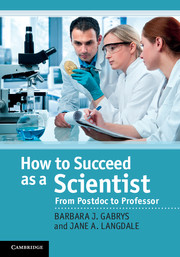Book contents
- Frontmatter
- Contents
- Preface
- Acknowledgements
- Part I Becoming an independent researcher
- 1 Managing your time
- 2 Giving a good research talk
- 3 Writing a quality research paper
- 4 Handling scientific criticism
- 5 Writing grant applications
- 6 Tools for managing research projects
- 7 Is there life beyond academia?
- 8 Applying for a job in academia
- 9 Applying for an independent research fellowship
- Part II Thriving in your new job
- Part III Managing your career
- Index
9 - Applying for an independent research fellowship
from Part I - Becoming an independent researcher
Published online by Cambridge University Press: 05 November 2011
- Frontmatter
- Contents
- Preface
- Acknowledgements
- Part I Becoming an independent researcher
- 1 Managing your time
- 2 Giving a good research talk
- 3 Writing a quality research paper
- 4 Handling scientific criticism
- 5 Writing grant applications
- 6 Tools for managing research projects
- 7 Is there life beyond academia?
- 8 Applying for a job in academia
- 9 Applying for an independent research fellowship
- Part II Thriving in your new job
- Part III Managing your career
- Index
Summary
In the last two decades there has been a change in the typical career path in academia, particularly in the UK. Previously, the normal trajectory would have been from PhD through one or two postdocs, to probationary lecturer/tenure-track Assistant Professor, and then to a tenured post. Nowadays, however, a favoured intermediate step between a postdoc and an academic job is an independent research fellowship (IRF). In this chapter we offer guidance on applying for IRFs and provide details of the various fellowships currently on offer.
The theory
An IRF allows you to build up an independent research programme before taking on teaching and administration commitments. The best fellowships range from 5 to 8 years – enough time to establish your own research group, break into a new field or map out a new one, and lay solid foundations for your future research programme. Importantly, applying for academic jobs from this position allows prospective employers to make a concrete assessment of your ability to gain research funding, to manage a research group and to publish independent research papers. Assuming that you have proven ability in these areas, you are in a strong position when applying for academic jobs – not only do you already have a good track record, but your employer knows that you will have the time and professional maturity to take on new teaching and administration duties. If you do not have proven ability in these areas, the fellowship has served to allow you to realise this for yourself.
- Type
- Chapter
- Information
- How to Succeed as a ScientistFrom Postdoc to Professor, pp. 93 - 96Publisher: Cambridge University PressPrint publication year: 2011



